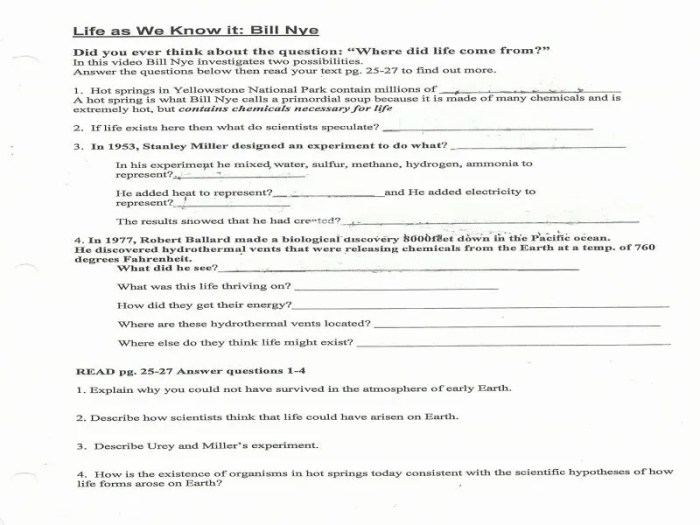Embark on an enlightening journey with the Bill Nye Waves Worksheet Answer Key, a meticulously crafted resource that unlocks the captivating world of waves and their intriguing properties. This comprehensive guide delves into the fundamental concepts, diverse types, and fascinating interactions of waves, empowering you with a profound understanding of these ubiquitous phenomena.
Through a seamless blend of theoretical explanations and practical applications, this answer key illuminates the complexities of wave behavior, guiding you through a comprehensive exploration of reflection, refraction, diffraction, interference, and standing waves. Prepare to immerse yourself in a world of scientific discovery and gain an unwavering grasp of wave dynamics.
Understanding Wave Properties

Waves are disturbances that transfer energy without transferring matter. They are characterized by three main properties: wavelength, amplitude, and frequency.
Wavelength is the distance between two consecutive crests or troughs of a wave. Amplitude is the maximum displacement of the wave from its equilibrium position. Frequency is the number of waves that pass a given point in one second.
These properties are related to the behavior of waves. For example, waves with shorter wavelengths have higher frequencies and travel faster than waves with longer wavelengths. Waves with larger amplitudes have more energy than waves with smaller amplitudes.
Types of Waves, Bill nye waves worksheet answer key
There are two main types of waves: transverse waves and longitudinal waves.
Transverse waves are waves in which the particles of the medium vibrate perpendicular to the direction of wave propagation. Examples of transverse waves include light waves and water waves.
Longitudinal waves are waves in which the particles of the medium vibrate parallel to the direction of wave propagation. Examples of longitudinal waves include sound waves and seismic waves.
Wave Interactions
Waves can interact with each other in a variety of ways. These interactions include reflection, refraction, and diffraction.
Reflection is the bouncing back of a wave from a surface. Refraction is the bending of a wave as it passes from one medium to another. Diffraction is the spreading out of a wave as it passes through an opening.
These interactions have a variety of consequences. For example, reflection can be used to create mirrors and lenses. Refraction can be used to create prisms and rainbows. Diffraction can be used to create holograms and optical fibers.
Wave Phenomena
Waves can also exhibit a variety of phenomena, such as interference and standing waves.
Interference is the interaction of two or more waves that results in the formation of a new wave pattern. Standing waves are waves that are confined to a particular region of space.
These phenomena have a variety of applications. For example, interference can be used to create optical filters and lasers. Standing waves can be used to create musical instruments and antennas.
Question & Answer Hub: Bill Nye Waves Worksheet Answer Key
What is the purpose of the Bill Nye Waves Worksheet Answer Key?
The Bill Nye Waves Worksheet Answer Key provides comprehensive solutions and explanations for the questions and activities included in the Bill Nye Waves worksheet, enhancing understanding of wave properties and phenomena.
What key concepts are covered in the Bill Nye Waves Worksheet?
The worksheet explores fundamental concepts such as wavelength, amplitude, frequency, wave types (transverse and longitudinal), wave interactions (reflection, refraction, diffraction), and wave phenomena (interference and standing waves).
How does the answer key benefit students?
The answer key offers clear and concise explanations, diagrams, and tables, aiding students in verifying their answers, identifying areas for improvement, and reinforcing their understanding of wave dynamics.


